Thursday, January 16th, 2020.
In this Daily: A Lifetime of Learning in Scuba, from Bubblemaker to Divemaster and Beyond
Diving is classified into two very broad categories: recreational diving and technical diving. Recreational diving is limited to depths of 130 feet, and follows certain no-decompression limits, while technical diving encompasses all other forms of deep diving, saturation diving, commercial diving, and any other diving exceeding 130 feet or the no-decompression limits.
Most divers focus on recreational diving, and from the first moment stepping in a pool in Bubblemaker to the Divemaster level and beyond, there is a whole lifetime of different skills and specializations available to tackle as a recreational diver.
PADI, one of the international standards for recreational diving certifications, and the most common in Costa Rica, has a progression starting at Bubblemaker and Discover Scuba Diving before proceeding all of the way up to Rescue Diver, with a number of different specialties and focuses along the way, followed by the terminal Divemaster and Master Diver tracks. All are available right in town through ConnectOcean.
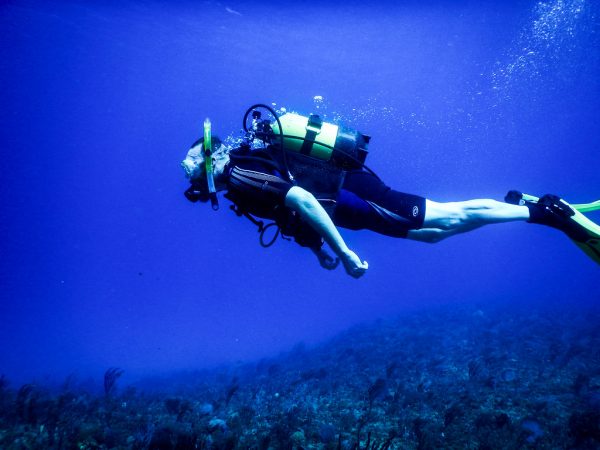 There is a lifetime's worth of specializations and learning to discover as a diver | PC: Commons
There is a lifetime's worth of specializations and learning to discover as a diver | PC: Commons
The PADI Dive Track
PADI (Professional Association of Dive Instructors) is considered one of the leading certification bodies of divers, along with SSI (Scuba Schools International), and NAUI (National Association of Underwater Instructors). In Costa Rica, PADI certification is more commonly used, and features a number of different certifications starting with the Bubblemaker/Discover Scuba Diver, proceeding on through the Open Water Diver, Adventure Diver, and Advanced Open Water Diver, and finally on to Rescue Diver, and the two terminal paths for recreational diving: Master Diver and Divemaster.
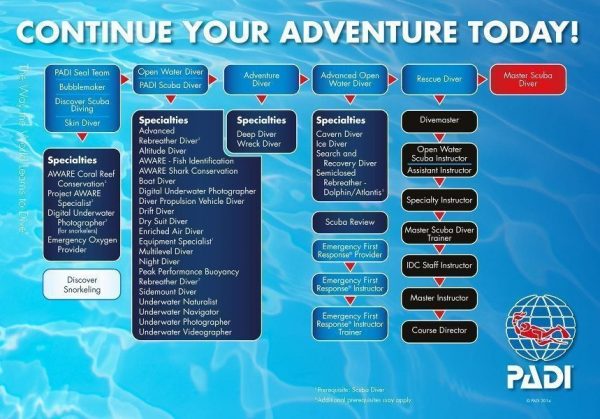 An overview of the PADI progression system. At top, the basic levels of progression, with numerous specialties along the way | PC: PADI
An overview of the PADI progression system. At top, the basic levels of progression, with numerous specialties along the way | PC: PADI
Bubblemaker/Discover Scuba Diver
The first level of diving certification is the Bubblemaker/Discover Scuba Diver track, where divers are first learning about the water. This level also includes the PADI Seal Team youth program and Skin Diver certifications, offering the opportunity for new divers to awaken a curiosity about life underwater.
For this level, specialties focus on introductory levels of conservation, underwater photography, and rescue assistance.
Open Water Diver/PADI Scuba Diver
The Open Water Diver/PADI Scuba Diver certifies a diver in the fundamentals of diving, leaving them capable and comfortable under the water, familiar with the basic equipment, and able to react to any of the problems that can arise while underwater. This entry level certification is like a driver’s license, and any reputable dive center will require that their divers be open water certified (unless they are hosting a bubblemaker/discover scuba diving course of their own). With the Open Water Diver/PADI Scuba Diver certification, divers can set out for the vast majority of the world’s dive sites, and further pursue their exploration of the water.
Once divers have been open water certified, the possibilities for specialties expand. This level adds a further layer of depth to conservation knowledge and photography, and introduces specialties with new equipment, dive styles, gas mixtures, and navigation, as well as night diving.
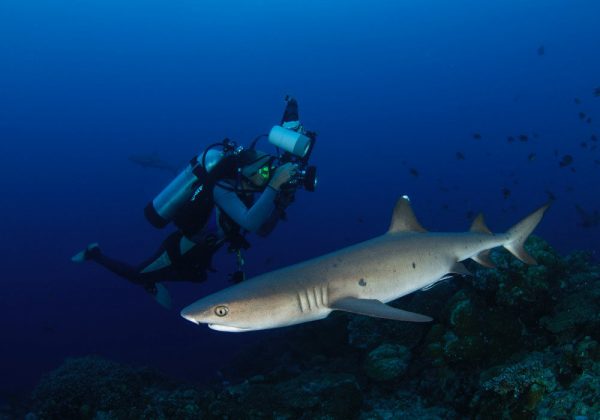 The Open Water and Advanced Open Water specialties provide a more in-depth focus on underwater photography, conservation, advanced equipment, and more varied environments
The Open Water and Advanced Open Water specialties provide a more in-depth focus on underwater photography, conservation, advanced equipment, and more varied environments
Advanced Open Water Diver
The Advanced Open Water Diver is the next step after achieving the Open Water Diver Certification, in which divers focus on mastering buoyancy control, underwater navigation, deep diving, low profile movement, and several specialties of their choice. The Advanced Open Water Diver Certification is given to a diver who has continued their education beyond the basic level, and is often required to dive slightly more advanced sites like Islas Murciélagos.
The specialties available within the Advanced Open Water Diver Certification expand further, to include Ice and Cavern Diving, Search and Rescue, and more technical rebreather work.
Rescue Diver
The Rescue Diver certification guides divers to take the next step in their education, and go from capable and safe divers in their own right to divers capable of protecting others and identifying problems while underwater. Certified Rescue Divers are trained to spot and identify potential challenges as second nature, and are equipped to handle a wide variety of rescue situations of varying complexity.
Once divers have completed their Rescue Diver certification, they are qualified to begin the two terminal courses for recreational divers, the Master Scuba Diver Certification and the Divemaster Track.
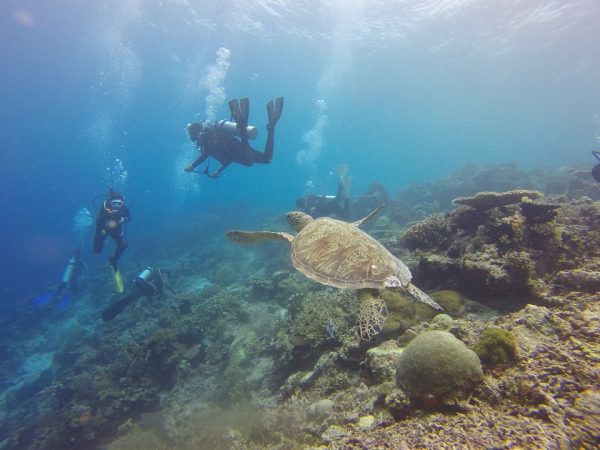 Divemasters and Master Divers are the two terminal certification tracks in PADI, and represent divers who have mastered their craft and provide leadership and experience to any dive group | PC: Commons
Divemasters and Master Divers are the two terminal certification tracks in PADI, and represent divers who have mastered their craft and provide leadership and experience to any dive group | PC: Commons
Mastering PADI Recreational Diving
PADI’s two terminal certifications, Master Scuba Diver and the Divemaster track, present the two options for divers to continue to learn and grow over many decades diving.
Master Scuba Diver
The Master Scuba Diver certification signifies a diver with extensive underwater experience, and can only be achieved once a diver has completed a minimum of 50 dives, the Rescue Diver Certification, and at least 5 PADI Specialties. Master Scuba Divers are qualified for any recreational dive site, and add to any dive group with their effortless buoyancy control and movement through the water, their calm and collected manner, and their ability to perceive and intervene in any potential problems before they occur.
Once reaching the Master Scuba Diver level, divers can continue in any of the PADI specialties, and tackle any challenge within the world of recreational diving.
The Divemaster Track
On the logo of PADI, the diver is holding a torch, which has come to represent the value of passing on diving experience to the next generation as a way to share the joy of the ocean. This is most prominently done through the Divemaster track, which starts with the fundamentals of supervising and organizing dives, and proceeds up to instructor training, and ultimately the instructors of instructors.
First, Rescue Divers are certified as Divemasters, who can plan, supervise, and lead dives. The role of the Divemaster is a fundamental one no matter where in the world you dive, as any PADI certified vessel will not let dives happen without a Divemaster.
After Divemasters are the dive trainers, who train new divers. First, aspiring trainers can be certified as Assistant Instructors, who can assist in the certification of new divers. The next level are the Open Water Dive Instructors, capable of leading courses to instruct new divers. In turn, Open Water Dive Instructors can next become Specialty Instructors, who can teach various specialties, and then Master Scuba Diver Trainers, who have shown a mastery of teaching many specialties and certified a certain number of students.
The next echelon of education are those who teach the instructors. The first level, IDC Staff Instructors, can assist in teaching new dive instructors. Next are the Master Instructors, who have participated in and certified a certain number of instructor courses.
The final level of formal education in the PADI process are the Course Directors, who are qualified to certify new IDC Staff Instructors and Master Instructors. However, there is one level above even the Course Directors: the PADI Examiners. These expert divers are the foremost in knowledge among the world’s divers, and oversee the selection and training of new course directors.
In all, the Divemaster track provides all who have shown their ability as divers to give back to the dive community through education to whichever level they desire.
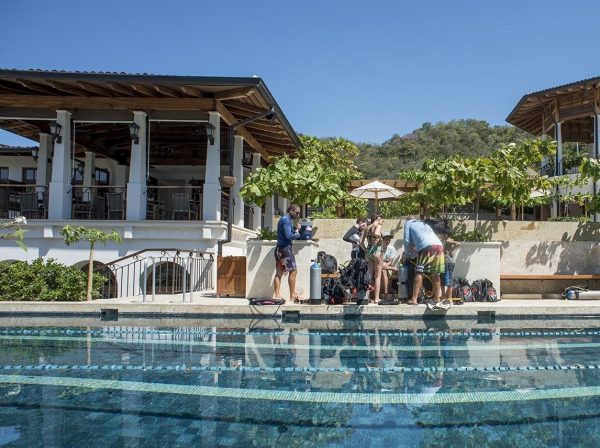 You can get certified in the vast majority of PADI levels and specialties with ConnectOcean, all right in Las Catalinas
You can get certified in the vast majority of PADI levels and specialties with ConnectOcean, all right in Las Catalinas
Learning from ConnectOcean
The ConnectOcean team has extensive diving and instruction experience, and the group is capable of certifying students up to Divemaster, Master Diver, and the introductory levels of instructor training. It’s a lifetime worth of diving and learning about the craft, all waiting right in the local waters.
Whether just getting started in Discover Scuba Diving or seeking to elevate your diving skills to Divemaster and beyond, ConnectOcean’s talented, experienced team can guide you every step along the way. To learn more about their programs and how to get started, simply reach out to the Las Catalinas concierge.
[maxbutton id="1" url="https://cta-redirect.hubspot.com/cta/redirect/4917861/57a68699-ed5d-4cbc-bd15-a3622b8b95d2" text="Dive with ConnectOcean" ]